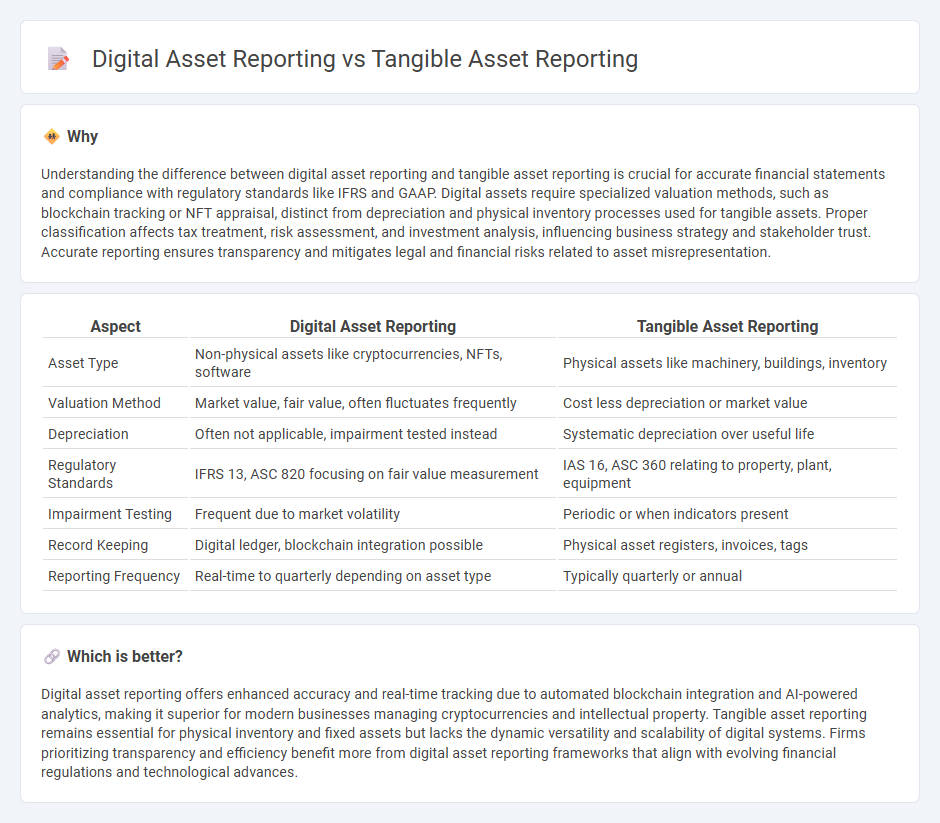
Digital asset reporting involves tracking and managing intangible assets such as cryptocurrencies, software licenses, and intellectual property using blockchain technology and advanced analytics, whereas tangible asset reporting focuses on physical items like machinery, buildings, and inventory with traditional methods like depreciation schedules and asset registers. The rapidly evolving regulatory landscape demands precise valuation and compliance standards for digital assets, contrasting with the well-established frameworks governing tangible assets. Explore more to understand how emerging technologies are reshaping asset reporting and accounting practices.
Why it is important
Understanding the difference between digital asset reporting and tangible asset reporting is crucial for accurate financial statements and compliance with regulatory standards like IFRS and GAAP. Digital assets require specialized valuation methods, such as blockchain tracking or NFT appraisal, distinct from depreciation and physical inventory processes used for tangible assets. Proper classification affects tax treatment, risk assessment, and investment analysis, influencing business strategy and stakeholder trust. Accurate reporting ensures transparency and mitigates legal and financial risks related to asset misrepresentation.
Comparison Table
| Aspect | Digital Asset Reporting | Tangible Asset Reporting |
|---|---|---|
| Asset Type | Non-physical assets like cryptocurrencies, NFTs, software | Physical assets like machinery, buildings, inventory |
| Valuation Method | Market value, fair value, often fluctuates frequently | Cost less depreciation or market value |
| Depreciation | Often not applicable, impairment tested instead | Systematic depreciation over useful life |
| Regulatory Standards | IFRS 13, ASC 820 focusing on fair value measurement | IAS 16, ASC 360 relating to property, plant, equipment |
| Impairment Testing | Frequent due to market volatility | Periodic or when indicators present |
| Record Keeping | Digital ledger, blockchain integration possible | Physical asset registers, invoices, tags |
| Reporting Frequency | Real-time to quarterly depending on asset type | Typically quarterly or annual |
Which is better?
Digital asset reporting offers enhanced accuracy and real-time tracking due to automated blockchain integration and AI-powered analytics, making it superior for modern businesses managing cryptocurrencies and intellectual property. Tangible asset reporting remains essential for physical inventory and fixed assets but lacks the dynamic versatility and scalability of digital systems. Firms prioritizing transparency and efficiency benefit more from digital asset reporting frameworks that align with evolving financial regulations and technological advances.
Connection
Digital asset reporting and tangible asset reporting intersect through unified financial tracking systems that integrate blockchain technology and RFID tagging for precise asset verification. Both reporting methods enhance transparency and accuracy in asset valuation, supporting regulatory compliance and audit readiness. Leveraging combined data analytics allows for comprehensive asset lifecycle management within accounting frameworks.
Key Terms
Depreciation vs. Amortization
Tangible asset reporting primarily involves depreciation, a systematic allocation of the asset's cost over its useful life, reflecting physical wear and tear. Digital asset reporting, however, emphasizes amortization, which systematically expenses the cost of intangible assets like software or patents over their estimated useful life. Explore more insights on how depreciation and amortization affect financial statements and asset valuation.
Physical Valuation vs. Fair Value Measurement
Tangible asset reporting centers on physical valuation methods, assessing assets like machinery, buildings, and inventory based on historical cost or depreciated replacement cost. Digital asset reporting emphasizes fair value measurement, reflecting market-based valuations for intangible items such as cryptocurrencies, digital rights, and software licenses. Explore comprehensive differences and standards to understand how these valuation approaches impact financial reporting accuracy.
Inventory Tracking vs. Blockchain Verification
Tangible asset reporting primarily involves inventory tracking systems, utilizing barcodes, RFID tags, and physical audits to monitor asset location and condition in real time. Digital asset reporting leverages blockchain verification, providing secure, immutable records and real-time transparency for asset ownership, transfers, and transactions. Explore the advantages and implementation strategies of both approaches to optimize your asset management processes.
Source and External Links
Tangible and Intangible Assets - This article provides an overview of tangible assets, including examples like inventory, buildings, and equipment, and how they are recorded on a balance sheet.
Tangible Assets - This resource explains how tangible assets are physical items of value, including land, cash, and equipment, and how they are listed on a balance sheet.
Inventories of Tangible Capital Assets - This document discusses the importance of maintaining accurate inventories of tangible capital assets, such as land and equipment, for governmental financial statements.
 dowidth.com
dowidth.com